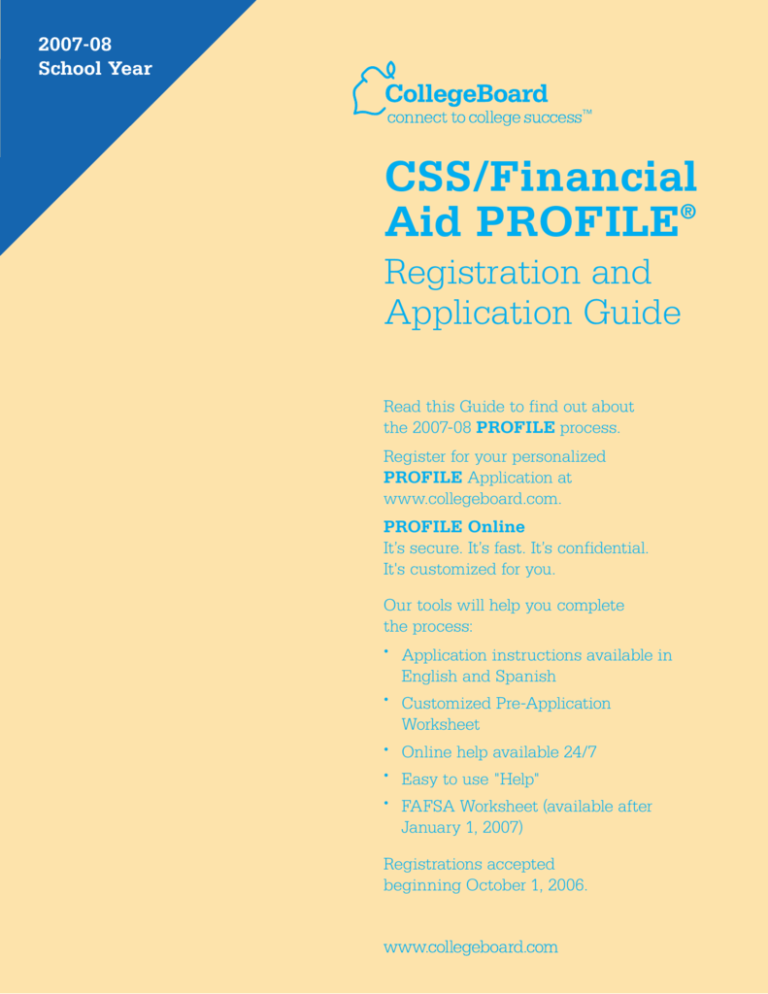The CSS Profile, or College Scholarship Service Profile, is an online application used by colleges and universities to determine a student’s eligibility for institutional financial aid. Developed by the College Board, the CSS Profile is used by over 400 colleges and universities nationwide to assess a family’s ability to pay for higher education. In this article, we will delve into the world of CSS Profile questions, exploring what to expect, how to prepare, and what the application process entails.

What is the CSS Profile?
The CSS Profile is a financial aid application that collects information about a family’s income, assets, and expenses to determine their Expected Family Contribution (EFC). The EFC is a calculated amount that represents the amount a family can reasonably contribute towards a student’s education. The CSS Profile is used in conjunction with the Free Application for Federal Student Aid (FAFSA) to determine a student’s eligibility for federal, state, and institutional financial aid.
Who Needs to Complete the CSS Profile?
Not all colleges and universities require the CSS Profile, so it’s essential to check with each institution to determine if it’s necessary. Generally, private colleges and universities, as well as some public institutions, use the CSS Profile to assess a family’s financial situation. If a student is applying to multiple colleges, they may need to complete the CSS Profile for each institution.
What Questions Will I Be Asked on the CSS Profile?
The CSS Profile consists of a series of questions that collect information about a family’s financial situation. The questions are divided into several sections, including:
- Student Information: This section asks for basic demographic information, such as name, date of birth, and social security number.
- Family Information: This section collects information about the student’s family, including parents’ names, occupations, and income.
- Income and Expenses: This section asks for detailed information about a family’s income, including wages, investments, and business income. It also inquires about expenses, such as housing costs, food, and transportation.
- Assets: This section collects information about a family’s assets, including savings, investments, and property.
- Additional Information: This section allows families to provide additional context about their financial situation, such as unusual expenses or financial burdens.
Some examples of CSS Profile questions include:
- What is your total household income?
- What is the value of your primary residence?
- Do you have any investments or savings accounts?
- What are your estimated expenses for the upcoming academic year?
- Have you experienced any significant financial changes in the past year?
How to Prepare for the CSS Profile
To ensure a smooth and accurate application process, it’s essential to prepare for the CSS Profile. Here are some tips to help you get started:
- Gather necessary documents: Collect all relevant financial documents, including tax returns, W-2 forms, and bank statements.
- Review the application: Familiarize yourself with the application questions and format.
- Create an account: Register for a College Board account to access the CSS Profile application.
- Complete the application: Fill out the application carefully and accurately, using the collected documents as reference.
- Submit the application: Submit the application by the specified deadline, usually in the fall or early winter.
Frequently Asked Questions (FAQ)
- Q: Is the CSS Profile the same as the FAFSA?
A: No, the CSS Profile and FAFSA are two separate applications. While both assess a family’s financial situation, the CSS Profile is used by individual colleges and universities, whereas the FAFSA is used for federal and state aid. - Q: How much does the CSS Profile cost?
A: The CSS Profile application fee is $25 for the first report and $16 for each additional report. - Q: Can I appeal my CSS Profile decision?
A: Yes, if you feel that your financial situation has changed or that the application did not accurately reflect your family’s circumstances, you can appeal the decision with the college or university’s financial aid office. - Q: Can I complete the CSS Profile online?
A: Yes, the CSS Profile can be completed online through the College Board website. - Q: What is the deadline for submitting the CSS Profile?
A: The deadline for submitting the CSS Profile varies by college or university, but generally falls in the fall or early winter.
Conclusion
The CSS Profile is an essential application for students seeking institutional financial aid. By understanding the questions and requirements, families can prepare and complete the application accurately and efficiently. While the CSS Profile may seem daunting, it’s a crucial step in determining a family’s eligibility for financial aid. By taking the time to review and prepare for the application, families can ensure that they receive a fair and accurate assessment of their financial situation. Remember to check with each college or university to determine if the CSS Profile is required, and don’t hesitate to reach out to the financial aid office if you have any questions or concerns. With careful planning and preparation, the CSS Profile can help families navigate the complex world of financial aid and unlock opportunities for higher education.
Closure
Thus, we hope this article has provided valuable insights into The CSS Profile: A Comprehensive Guide to Financial Aid. We thank you for taking the time to read this article. See you in our next article!